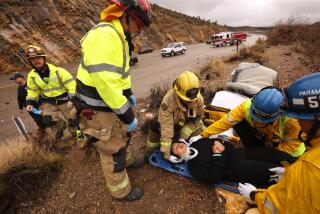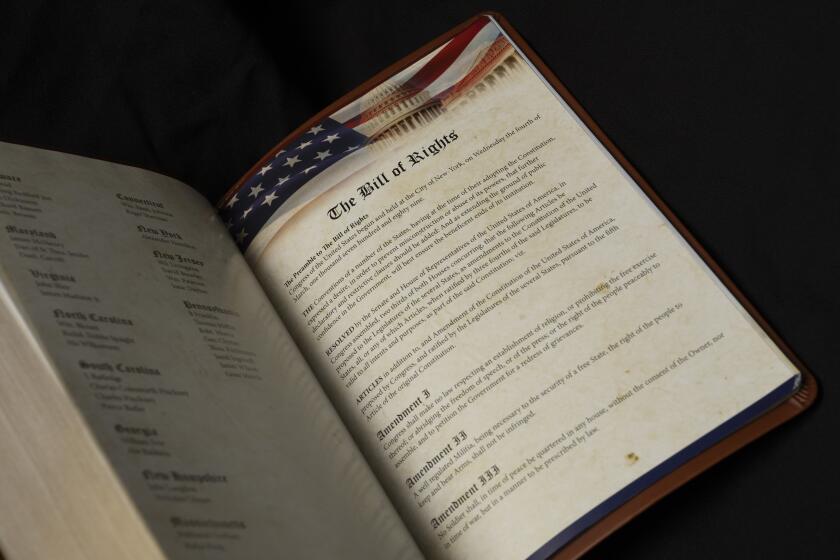Firefighters were ‘all great guys’
MEDFORD, ORE. — It followed the common pattern. At first, details were few: nine fatalities in the crash of a helicopter ferrying firefighters in the Shasta-Trinity National Forest. Seven of the dead and three of the injured were contract firefighters, hired hands brought down from Oregon to bolster the lines in an onslaught of Northern California fires.
Later in the week names and ages were released, followed by face-shot photographs posted on a company website. By Friday, details about the dead had started to emerge, and it was at this point, as numbers and names were replaced by human narratives, that the true dimension of the tragedy became clear.
More than fire gypsies, these were promising young men, actively engaged in the business of building their lives. Their loss created holes, not only in their families, but also on college campuses and in communities up and down the Rogue Valley of southern Oregon.
“They were all great guys,” said Ed Float, a 61-year-old former smoke jumper who is now a mainstay of Grayback Forestry, a pioneer firefighting contractor headquartered in Merlin, Ore.
The lost firefighters all were Graybackers, as they are called, and Float had trained most of them.
Stooped shoulders and a faraway gaze testifying to the emotional toll the week had taken, Float stood outside the company’s Medford base Friday and tried to make these men come alive for reporters who had gathered in the parking lot.
He spoke in particular of Matt Hammer, a strapping, 23-year-old graduate of a small Christian college who had married his college sweetheart only a month before the crash.
“Matt Hammer,” he said, saying the name with reverence. “Matt Hammer was special. Matt called me, he was at a seminary school and said he wanted a job. Typically I want to meet someone before we hire them. I want to look at their hands, see if they can work.
“But as I talked to Matt, I made him an offer right there. There was just something about him. One of his callings was an evangelist minister. I always had him do a morning prayer before we went on to a fire. He wasn’t maybe the greatest preacher, but everything he said came from the heart.”
Float said Hammer would have been his first choice to deliver a eulogy for the lost crew members. And then he shook his head and said no more.
The privately owned Sikorsky helicopter was airlifting Grayback crews, 10 members at a time, from the northeastern front of the Iron Complex fire back to their base camp. It should have been a 10-minute hop, sparing the firefighters a steep, three-hour hike uphill, followed by a one-hour trip by van on twisting roads.
“I can pretty much tell you exactly what they were feeling when they boarded,” said Jesse Kiene, 29, assistant manager of Grayback’s Medford base and during fire season the boss of a 20-member crew. “They would have been excited. We all love to fly in helicopters.”
It’s a rare treat for contractor crews. While some are trained to engage in initial strike attacks on fires, more often their work is of a secondary nature -- “mopshots,” they are sometimes dismissively called by government agency crews, a play on their own fabled hotshots.
“You run into the attitude, ‘Oh, you are just another contractor,’ ” Kiene said. “There is that skew against us.”
This friction in part dates from a period when contracts were awarded to low bidders, not all of which maintained high standards. Grayback, founded three decades ago, is run by former smoke jumpers, and company officials insist their training regimens and firefighter requirements match or exceed those of any agency.
Kiene also said there is a natural “sibling rivalry between every sort of firefighting” -- smoke jumpers and “ground-pounders,” hotshots and contractors -- “but we all wear yellow shirts and green pants.” And, as the crash last week made painfully obvious, the danger posed by wildfires plays no favorites.
Fresh back from the fire, his gray T-shirt smudged, Kiene sat in his office Thursday and ran down the list of half a dozen names Grayback had just released, crew members “presumed to have perished in the crash.”
“Shawn Blazer. A good, dependable, honest person who was working to make a career out of it. He was 30, older than most, single, with no kids. He took care of his mom. . . . Scott Charleson. Scott was a guy I recruited this year. He was an all-star defense lacrosse player at Southern Oregon University, out of Ashland. . . . Matt Hammer. Matt Hammer is rough.”
He lowered his head a moment.
“I hadn’t seen him this year. He’d been out on fires since he got back from his honeymoon. . . .”
Kiene worked in this way through those presumed to have died -- removing, let alone identifying, remains from the all-but-melted helicopter had been difficult -- and then added what he could about the three injured Grayback men. He knew them, of course, but primarily as firefighters.
It fell to family and friends to supply fuller portraits. At Southern Oregon University, three professors and a student sat in a lecture hall and spoke for nearly an hour about Edrik Gomez, 19, and Charleson, 25.
Gomez was the son of Mexican immigrants. His parents came to work in the fields, made some money in real estate and sent three sons to college. “He had such potential,” a friend, Nicole Jolly, said through tears.
Charleson wanted to become a sports reporter and believed firefighting would offer an opportunity to earn tuition and also hone his writing skills: “He was going to keep a diary, get a feel for it,” recalled D.L. Richardson, the communication department chair.
In a house not far from campus, 19-year-old Tysin Senestraro sat on a couch and talked about David Steele, also 19, best friend since they were 6: “All through his life, he wanted to be a firefighter.” He had taken college courses to learn emergency medicine, and he had joined Grayback.
“He wanted to be a fire chief someday. Raise a family and be a chief in some town. He didn’t want people to just think he was a hero. He wanted to actually run into burning buildings and save lives.”
This was Friday afternoon, and Senestraro was talking as a favor to Steele’s family. With no body yet to bury, Paul Steele, David’s father, just wasn’t ready to talk about his son.
Earlier that day he had tried, standing on his front lawn, barefoot, in shorts and a T-shirt, eyes red.
“We don’t want to talk right now,” he explained softly, standing next to his wife, Suzanne. It was too early, too raw. Perhaps a friend would be better, and Suzanne left to look up Senestraro’s phone number.
As he waited for his wife to return, the father tried his best to make a stranger understand the essence of his son. He recalled a high school football game where David, a defensive lineman, made an important interception. A picture of the moment had been broadcast on Medford television the night before.
“He was in his glory then,” the father said, stopping at almost every sentence to press his fingers against his temples, trying to contain the sobs. “All his buddies were hugging him. I want that to be remembered. Not our grief.”
He described David’s bond with his three younger siblings, the rollicking sock fights they’d have, their anticipation of his homecomings from college.
“We didn’t raise him for this,” Paul Steele said. “I don’t know of anybody who was David’s enemy.”
Suzanne returned with the phone number and two pictures.
“We want him to be honored,” Paul Steele said finally. “He deserves that. He is not just a name and an age on a list. We want his story told.”
But it’s hard, he said, “so hard.”
--
More to Read
Sign up for Essential California
The most important California stories and recommendations in your inbox every morning.
You may occasionally receive promotional content from the Los Angeles Times.











